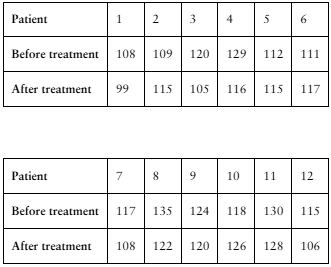How do you know whether to use a Wilcoxon signed-rank test or a Wilcoxon rank sum test?
Table of contents
- 1. Intro to Stats and Collecting Data1h 14m
- 2. Describing Data with Tables and Graphs1h 55m
- 3. Describing Data Numerically2h 5m
- 4. Probability2h 16m
- 5. Binomial Distribution & Discrete Random Variables3h 6m
- 6. Normal Distribution and Continuous Random Variables2h 11m
- 7. Sampling Distributions & Confidence Intervals: Mean3h 23m
- Sampling Distribution of the Sample Mean and Central Limit Theorem19m
- Distribution of Sample Mean - Excel23m
- Introduction to Confidence Intervals15m
- Confidence Intervals for Population Mean1h 18m
- Determining the Minimum Sample Size Required12m
- Finding Probabilities and T Critical Values - Excel28m
- Confidence Intervals for Population Means - Excel25m
- 8. Sampling Distributions & Confidence Intervals: Proportion1h 25m
- 9. Hypothesis Testing for One Sample3h 57m
- 10. Hypothesis Testing for Two Samples4h 50m
- Two Proportions1h 13m
- Two Proportions Hypothesis Test - Excel28m
- Two Means - Unknown, Unequal Variance1h 3m
- Two Means - Unknown Variances Hypothesis Test - Excel12m
- Two Means - Unknown, Equal Variance15m
- Two Means - Unknown, Equal Variances Hypothesis Test - Excel9m
- Two Means - Known Variance12m
- Two Means - Sigma Known Hypothesis Test - Excel21m
- Two Means - Matched Pairs (Dependent Samples)42m
- Matched Pairs Hypothesis Test - Excel12m
- 11. Correlation1h 24m
- 12. Regression1h 50m
- 13. Chi-Square Tests & Goodness of Fit2h 21m
- 14. ANOVA1h 57m
10. Hypothesis Testing for Two Samples
Two Means - Matched Pairs (Dependent Samples)
Problem 11.2.3a
Textbook Question
Performing a Wilcoxon Test In Exercises 3–8,
a. identify the claim and state H0 and Ha.
[APPLET] Calcium Supplements and Blood Pressure In a study testing the effects of calcium supplements on blood pressure in men, 12 men were randomly chosen and given a calcium supplement for 12 weeks. The table shows the measurements for each subject’s diastolic blood pressure taken before and after the 12-week treatment period. At α = 0.01, can you reject the claim that there was no reduction in diastolic blood pressure? (Adapted from The Journal of the American Medical Association)

 Verified step by step guidance
Verified step by step guidance1
Step 1: Identify the claim and hypotheses. The claim is that there was no reduction in diastolic blood pressure after the calcium supplement treatment. The null hypothesis (H₀) is that the median difference between the before and after treatment blood pressure measurements is zero (no reduction). The alternative hypothesis (Hₐ) is that the median difference is less than zero (indicating a reduction).
Step 2: Calculate the differences between the before and after treatment blood pressure measurements for each patient. For each patient, subtract the 'After treatment' value from the 'Before treatment' value to obtain the differences.
Step 3: Rank the absolute values of the differences from smallest to largest, ignoring the sign of the differences. Assign ranks to these absolute differences, and note the sign of the original differences (positive or negative).
Step 4: Sum the ranks of the negative differences (i.e., those indicating a reduction in blood pressure). This sum will be used as the test statistic for the Wilcoxon signed-rank test.
Step 5: Compare the test statistic to the critical value for the Wilcoxon signed-rank test at α = 0.01 for a sample size of 12. If the test statistic is less than or equal to the critical value, reject the null hypothesis (H₀). Otherwise, fail to reject the null hypothesis.
 Verified video answer for a similar problem:
Verified video answer for a similar problem:This video solution was recommended by our tutors as helpful for the problem above
Video duration:
5mPlay a video:
Was this helpful?
Key Concepts
Here are the essential concepts you must grasp in order to answer the question correctly.
Wilcoxon Test
The Wilcoxon Test is a non-parametric statistical test used to compare two related samples, matched samples, or repeated measurements on a single sample to assess whether their population mean ranks differ. It is particularly useful when the data does not meet the assumptions required for a t-test, such as normality. In this context, it helps determine if there is a significant difference in diastolic blood pressure before and after treatment.
Recommended video:
Guided course

Independence Test
Hypothesis Testing
Hypothesis testing is a statistical method that uses sample data to evaluate a hypothesis about a population parameter. It involves formulating two competing hypotheses: the null hypothesis (H0), which states there is no effect or difference, and the alternative hypothesis (Ha), which indicates the presence of an effect or difference. In this case, H0 would claim no reduction in blood pressure, while Ha would suggest a reduction.
Recommended video:
Guided course

Step 1: Write Hypotheses
Significance Level (α)
The significance level, denoted as α, is the threshold for determining whether a statistical result is significant. It represents the probability of rejecting the null hypothesis when it is actually true (Type I error). In this scenario, α = 0.01 indicates a 1% risk of concluding that there is a reduction in diastolic blood pressure when there is none, thus requiring strong evidence to reject H0.
Recommended video:

Finding Binomial Probabilities Using TI-84 Example 1

 8:33m
8:33mWatch next
Master Introduction to Matched Pairs with a bite sized video explanation from Patrick
Start learningRelated Videos
Related Practice
Textbook Question
86
views
